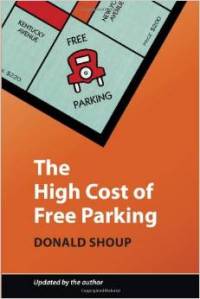
In a presentation at Build Maine 2015 , I started off this list with these two bullets:
- Lousy Streets and Lousy Public Spaces make it harder to sell or rent buildings. They drag down the local economy and make the town uncompetitive..
- Contaminated Sites require a lot of extra work.
The first bit about lousy streets and lousy public spaces should be obvious, but it can be hard to really understand the numbers on this issue, and how you got the lousy streets you have now in some parts of town. Those lousy streets were built to a very specific set of standards The wrong stuff built with tremendous precision. It is mind boggling to find out that lousy streets are built to a legal standard, while the best streets in your town may be illegal to build today. Which brings us to the second bullet. Contaminated sites require way more work to build upon. I’m not referring to chemical contamination. I’m talking about sites that are contaminated by bogus rules and ordinances that just don’t work any more, but nobody has been willing to clear them out. Sites that are Administratively Contaminated need to be cleaned up. If you wait for the individual property owners or developers to do that clean up, it could be a very long time before your town is competitive. Towns that can show leadership in cleaning up Administrative Contamination will perform better than their neighbors. So here is the list of stuff a town can step up and do to show their resolve in making their community better:
An added Note. Comments on Twitter described this post as hopping from the Essential to the Useful, So I have annotated each item as Essential or Useful
Dump Functional Classification —Replace with NACTO Replacing the grid or network of streets with the stem and branch system required under Functional Classification was a really bad idea. It produced high levels of congestion with fairly low volumes of traffic by concentrating trips on a small number of really wide and fast roads. Providing cyclists and pedestrians with a fighting chance with the stupid Functional Classification requirements still in place is blind and wasteful. Dump the bad rules and adopt the Design Standards published by the National Association of City Transportation Officials (NACTO).(Essential)
AMEND the International Fire Code for local use–Repeal 20’ Clear and Appendix D The International Fire Code is hazardous to the communities it is intended to serve, because it is the source of overly-wide streets which promote faster car movement and result in more serious vehicle injury accidents and more people getting hit by cars getting maimed or dead. Appendix D in the Fire Code requires 26′ clear for streets fronted by a single building greater than 30 feet tall (even when that building has fire sprinklers. (Essential)
Stop Using the Wrong Damned Ambulance –Firefighters should not design streets. If 80% of emergency responses in your town are medical and only 20% are vehicle and structure fires, why roll fire engines to medical calls (just in case the first responders have to continue on to a fire). The second part got me into some trouble with local folks. I am still pissed off that in the town I lived in for 15 years, (Chico, CA) The starting salary for a firefighter with a high school education and some time at the Community College Fire Academy is $90,000 plus pension and benefits. This is going on in a place where the Area Median Income (AMI) for a household of four is $43,752. The firefighters I know are operating building companies on the side in addition to their generous salary and benefits. The last time a position opened up for an entry level firefighter, there were over 600 applications. I should have checked on the local situation in Maine where firefighters in Auburn and Bangor start at about 70% of AMI. So I upset some folks by being wrong on the local situation. We can argue about the pay scale for firefighters but it is more important to recognize they have done a lousy job designing streets in communities across the country. Relieving them of that authority will help your town. (Useful. Be mindful of where you invest your political capital. Taking on the Fire Department will bring forward all sort of nostalgic and heartfelt -but irrational reactions from the general public. Get some of the other stuff on this list done first and the problems presented by having the fire marshal control the design of your streets will come into sharper relief).
Overhaul your Off-Street Parking Requirements, Manage your Public Parking Properly,–Dump ITE Manual / Read Don Shoup Municipalities are tremendously bad at guessing how much off-street parking should be required for a given building. The closest thing to an object standard they can point to is a collection of tables with decimal points published by the Institute of Transportation Engineers. Those tables were developed by surveying single use suburban parking lots and are being mistakenly applied to downtown settings which also have on-street parking. Somebody asked me where spending $1200 would do the most good in Municipal government. It would be a book club formed from the City Council, Planning Commission and Senior staff assigned Donald Shoup’s book The High Cost of Free Parking. At $30 a copy that’s 40 copies.
For an explanation of why the ITE parking numbers are quite bogus, check out Shoup’s paper Roughly Right or Precisely Wrong? (Essential)
Come to Terms with your Zoning Code. Is your zoning code a collection of amendments and post-it notes that tarted in 1958 with an off the shelf ordinance from some outfit in Atlanta? Do it prohibit the worst possible thing from happening and allow the next to the worst possible thing to be built as-of-right? How many special exceptions and variances does it take to build stuff that you say you want in you Comprehensive Plan? (Useful -but only because as tangled as some zoning codes are changing the rules can be a needlessly drawn out process. Essential that you get started, but less critical than changing the off-street parking requirements).
Provide an Alternative to your Current Process for Building Permits, Inspections, Plan Check –Self Certification When an Architect or Engineer stamps a set of building plans they are taking personal liability for any failure to meet the building code or established professional standards of practice. When a municipal plan checker approves a set of plans for construction or if a building inspector approves the building for occupancy, the municipality has no liability. If you are the architect stamping the drawings and a city staffer tells you to change something or the building permit won’t be approved, what do you do? What if you know the requested change is outside the requirements of the building code? Some communities have passed ordinances recognizing where liability for code compliance falls and have allowed Architects and Engineers to certify their work subject to some peer review. This would be a way to reduce the time, expense, and frustration in the building permit processes of many towns. (Useful -but hey come on, as long as you have the hood up do this thing too.)
Be Rigorous about Municipal Finance –Do the Math. Many towns do their books without considering the cost of repairing and replacing infrastructure that will be wearing out. They don’t have a good handle on what parts of town generate the most revenue per acre, or the most cost per acre. Without those numbers, it is hard to see the reality of how the wrong pattern of development can be really expensive. Take a look at the work that StrongTowns is doing in Lafayette, Louisiana. See how your town measures up when you do the math. (Essential)















